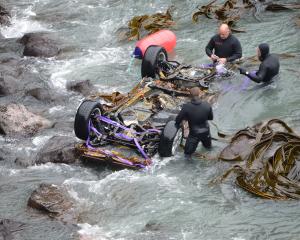The New Zealand Aluminium Smelter (NZAS) in Bluff is looking into building a plant to process thousands of tonnes of highly toxic waste stored on-site.
This initiative has been met with approval from the Bluff Community Board, which is eager to see action taken to prevent the waste from remaining in landfill.
Spent cell liner (SCL), a byproduct of the aluminium smelting process, contains hazardous substances such as cyanide and fluoride.
When exposed to water, SCL can release toxic and explosive gases including hydrogen, methane and ammonia.
Over 200,000 tonnes of this material are stored at the site.
It is more toxic than the dross and ouvea mix that in the past posed a threat at Mataura, since been moved back to Tiwai Point.
Earlier this week, NZAS communities and social performance manager Dion Williams provided the Bluff Community Board with an update on the proposed SCL processing plant.
Chairman Raymond Fife said Mr Williams discussed plans to export about 35,000 tonnes of SCL annually over a five-year period through the Bluff port.
Speaking to the Otago Daily Times, chairman Raymond Fife said Mr Williams spoke about the process.
"The concern from the community was that we’ve had hazardous cargoes come through the port and they were just delaying fares.
"That’s not the case [now] — they’re going through the consultation and getting the community fully informed about what the process is going to be going forward and we’re reasonably happy with what was presented to us."
NZAS external affairs director Simon King said as part of its ongoing environmental remediation plan, the company aimed to remove and reprocess all SCL from Tiwai by 2029.
Since 2020, about 32,000 tonnes of SCL had been exported for reprocessing.
To accelerate the removal of SCL, NZAS had initiated a feasibility study, including applying for regulatory consents, to establish an on-site processing facility.
This facility would transform the SCL into a non-hazardous material for use as a feedstock in the cement industry.
A final decision to proceed with the project had not been made and no timeline was given.
Additionally, questions regarding the cost of the project and potential job creation in the region remain unanswered.
In 2021, RNZ reported an investigation revealed SCL had been buried in unmapped sites at Tiwai, and the product was banned from being buried untreated.
Subsequently, NZAS announced it was storing thousands more tonnes of the potentially hazardous waste material than previously reported, increasing the total to 217,000 tonnes, up from an earlier estimate of 181,000 tonnes.
The following year, RNZ also obtained documents which showed the company was "desperate" to get exporting under way for the waste and asked repeatedly for the Environmental Protection Authority to move faster on helping it get a permit to ship the SCL offshore.












